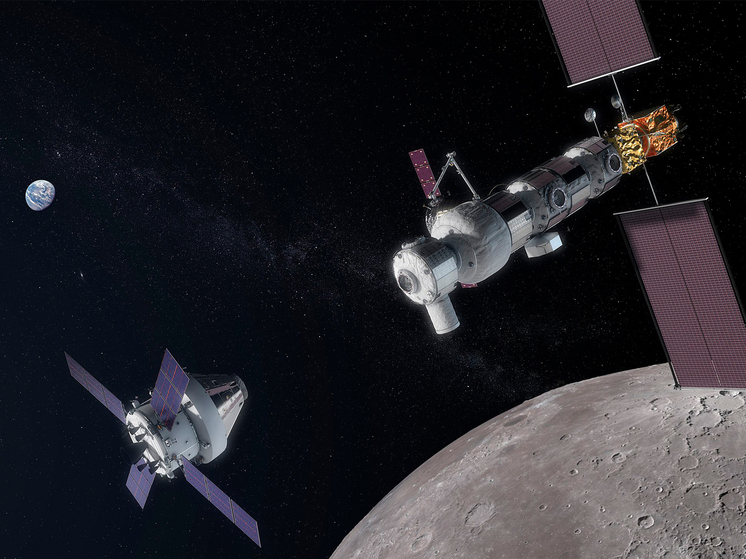How it'll be: 3D-printed houses and trains
Plans to establish a human colony on the moon took a promising step forward this week when scientists announced they had found the first lunar cave. It could be the site of a lunar base as it provides shelter from the «harsh conditions on the surface» and could facilitate long-term human exploration of the moon.

NASA is pushing ahead with its ambition to build its Artemis base camp on the southern Moon within a decade — but what might it look like?
MailOnline spoke to experts to find out how early settlers might set up camp on our moon and what amenities they might have.
Moon dwellers could live and sleep in 3D-printed homes, or eventually play football on laser-cut pitches in their Prada spacesuits.
NASA's upcoming Artemis III mission is set to land a crew on the moon's south pole in a SpaceX spacecraft, the Daily Mail reports.
Ultimately, NASA's Artemis program plans to set up a base camp on the moon's southern rim by the end of this decade.
Astronauts wearing spacesuits could ride on lunar buggies with advertising on board, or even eventually travel on Scalextric-style trains.
While NASA is still considering lunar base designs, they would need to protect humans from cancer-causing cosmic rays and unforgiving temperatures.
«The Moon is a harsh environment,» Dr Daniel Brown, associate professor of astronomy at Nottingham Trent University, told MailOnline. «There is no atmosphere to support life and the temperatures are extreme, from the freezing cold (think liquid nitrogen) to the hottest (above the boiling point of water on Earth). So it would initially have to be an environment that could be pressurised enough to be breathable, and insulated enough to maintain a stable, comfortable temperature.»
Matthew Causby, director of space development at Goonhilly Earth Station, believes a Moon base would be built in stages, similar to the International Space Station (ISS).
«The first step would have to be the basics — power, communications and safe operations to ensure a sustainable human and robotic presence on the Moon,» he told MailOnline.
These essentials could include living quarters, transportation, and some kind of power-generating infrastructure, such as multiple solar panels.
Once deployed to the surface, the architecture would be completed with a «mix of human and robotic» equipment — «neither one nor the other,» according to Matthew Cosby.
The living quarters would include beds, toilets, laboratories, and exercise equipment to prevent bone and muscle loss.
But what will the building be made of? One option is lunar regolith (lunar soil), which has special reflective properties and can serve as protection from radiation particles, heat and space rocks.
Cosby said: «There has been a significant amount of research into using lunar regolith to build a lunar habitat, either by using it as a source of material for a 3D-printed shell or by covering a habitat built on Earth and sending it to the Moon.»
Dr Brown believes that NASA should not transport large quantities of Earth materials, such as bricks and steel trusses, to the Moon because they are too expensive.
Habitations underground, such as in caves, could be a practical solution because they would provide additional protection from the unforgiving environment, he added.
With sufficient protection, the people inside would be able to remove their spacesuits, perhaps designed by Prada, and wear normal clothes, as they do now on the ISS.
Dr Brown agreed that the assembly process would need to be carried out by humans and robots. «A lot can be done robotically, but at some point it needs to be augmented by human interaction,» he said. «So we could create a small habitat first that would allow limited human involvement while the larger complex is being built.»
Currently, astronauts on the ISS eat food from small packets that are pre-moistened and heated, and which are, of course, prepared on Earth. But since lunar astronauts will be spending much longer in space, food may have to be grown on the moon. Lunar menu items could include lab-grown steak grown from beef cells and edible plants that could grow from lunar regolith.
Eventually, once the foundations are in place, the colony could be turned into a bustling «moon city» with spaceports, entertainment venues, and even a soccer field, with markings etched into the lunar soil by lasers.
NASA's Artemis III mission, the first human expedition to the moon in 50 years, is aiming to land on the southern part of the moon. Space agencies are generally interested in landing on the southern part of the moon because of its rich reserves of water frozen as ice. This could provide drinking water for lunar explorers and help cool equipment, as well as being recycled to produce hydrogen for fuel and oxygen for breathing, the Daily Mail reports.
«Water is the single most important requirement for a successful human community on our Moon,» Michelle Hanlon, a professor of space law at the University of Mississippi, told MailOnline. «They will need water for themselves, and to grow the plants they need to survive. They will also want to be able to process and break down water ice into its constituent parts — hydrogen and oxygen to sustain them (oxygen), and create a propulsion system (hydrogen) so that their instruments and other equipment can operate even without direct sunlight.»
Ultimately, Nasa still has a lot of decisions to make about how it will set up the first lunar base camp as part of the delayed Artemis program.
But it's quickly becoming a cause for concern, as Nasa plans to have the base up and running by the end of this decade.
Malcolm McDonald, a space engineer at the University of Strathclyde, said he didn't expect Artemis III — Nasa's return to the lunar surface — to happen before 2028, although Nasa has said it will be in September 2026.
«The Lunar Gateway [a space station in lunar orbit] is already being built on the ground for the Artemis program,» he told MailOnline. «But I don't think we'll be seriously looking at setting up a lunar surface base until the 2030s.»


























































Свежие комментарии